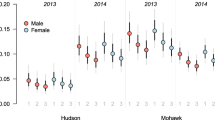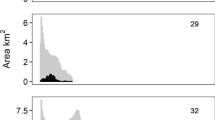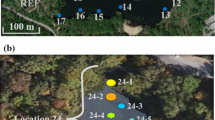Abstract
Spatial scale is rarely considered in population-level assessments of contaminant impacts on wild animals; as a result misinterpretation of the relationship between contaminant exposure and population status may occur. We assessed the strength of expression of polychlorinated biphenyl (PCB) exposure effects at local vs. regional spatial scales on population status in five species of waterbirds, “bioaccumulators” often promoted as indicators of contaminant effects in aquatic ecosystems. Our focus was the upper Hudson River where PCBs occur at levels reported to have adverse impacts on wild birds. At the local scale, waterbird habitat occupancy was estimated from 220 repeat surveys made between 2001 and 2010 along the same survey route divided into 25 contiguous river segments with markedly different PCB concentrations. At the regional scale, waterbird habitat occupancy in relation to proximity to the upper Hudson River was estimated across 1248 Breeding Bird Atlas survey blocks while controlling for region-wide variation in habitat availability. At the local scale, many associations of habitat and sampling covariates with species detection probabilities were evident but none, including PCB concentration, with habitat occupancy, extinction or colonization of a given river segment. At the regional scale, survey effort and habitat factors not related to PCB exposure were the most important drivers of waterbird occurrence although two species were more likely to occur farther from the contaminated river segment. Spatial scale clearly mediates expression of contaminant impacts on wild bird populations; large-scale, expert-generated databases provide an underused opportunity for better delineating the spatial scales at which population impacts occur and risk assessments should be performed.

Similar content being viewed by others
References
Andrle RF, Carroll JR (1988) The atlas of breeding birds in New York State. Cornell University Press, Ithaca
Baillie SR, Sutherland WJ, Freeman SN et al. (2000) Consequences of large-scale processes for the conservation of bird populations. J Appl Ecol 37:88–102
Baron LA, Ashwood TL, Sample BE et al. (1997) Monitoring bioaccumulation of contaminants in the belted kingfisher (Ceryle alcyon). Environ Monit Assess 47:153–165
Best DA, Elliott KH, Bowerman WW et al. (2010) Productivity, embryo and eggshell characteristics, and contaminants in bald eagles from the Great Lakes, USA, 1986 to 2000. Environ Toxicol Chem 29:1581–1592
Börger L, Nudds TD (2014) Fire, humans, and climate: modeling distribution dynamics of boreal forest waterbirds. Ecol Appl 24:121–141
Burnham KP, Anderson DR (2002) Model selection and multimodel inference: A practical information-theoretic approach, 2nd edn. Springer, New York
Butler RW (1992) Great blue heron (Ardea herodias). In: Poole A, Stettenheim P, Gill F (eds) The Birds of North America, No. 25. The Birds of North America, Inc., Philadelphia, Philadelphia (PA)
Carlsen TM, Coty JD, Kercher JR (2004) The spatial extent of contaminants and the landscape scale: an analysis of the wildlife, conservation biology, and population modeling literature. Environ Toxicol Chem 23:798–811
Cox SB (2010) Statistical models in wildlife toxicology. In: Kendall RJ, Lacher TE, Cobb GP, Cox SB (eds) Wildlife toxicology: Emerging contaminant and biodiversity issues. CRC Press, Boca Raton
Custer CM, Custer TW, Allen PD, Stromborg KL, Melancon MJ (1998) Reproduction and environmental contamination in tree swallows nesting in the Fox River drainage and Green Bay, Wisconsin, USA. Environ Toxicol Chem 17:1786–1798
Custer CM, Custer TW, Dummer PM, Munney KL (2003) Exposure and effects of chemical contaminants on tree swallows nesting along the Housatonic River, Berkshire County, Massachusetts, USA, 1998–2000. Environ Toxicol Chem 22:1605–1621
Custer TW, Custer CM, Gray BR (2010a) Polychlorinated biphenyls, dioxins, furans, and organochlorine pesticides in spotted sandpiper eggs from the upper Hudson River basin, New York. Ecotoxicology 19:391–404
Custer TW, Custer CM, Gray BR (2010b) Polychlorinated biphenyls, dioxins, furans, and organochlorine pesticides in belted kingfisher eggs from the upper Hudson River basin, New York, USA. Environ Toxicol Chem 29:99–110
Custer TW, Hines RK, Melancon MJ et al. (1997) Contaminant concentrations and biomarker response in great blue heron eggs from 10 colonies on the upper Mississippi River, USA. Environ Toxicol Chem 16:260–271
Devictor V, Whittaker RJ, Beltrame C (2010) Beyond scarcity: Citizen science programmes as useful tools for conservation biogeography. Divers Distrib 16:354–362
Elliott JE, Butler RW, Norstrom RJ et al. (1989) Environmental contaminants and reproductive success of great blue herons Ardea herodias in British Columbia, 1986-1987. Environ Pollut 59:91–114
Elliott JE, Levac J, Guigueno MF et al. (2012) Factors influencing legacy pollutant accumulation in alpine osprey: biology, topography, or melting glaciers? Environ Sci Technol 46:9681–9689
Elliott JE, Morrissey CA, Henny CJ et al. (2007) Satellite telemetry and prey sampling reveal contaminant sources to Pacific Northwest ospreys. Ecol Appl 17:1223–1233
EPA (United States Environmental Protection Agency) (1998) Guidelines for ecological risk assessment.EPA/630/R-95/002F. Risk Assessment Forum, Washington, DC.
EPA (United States Environmental Protection Agency) (1999) Issuance of final guidance: Ecological risk assessment and risk management principles for superfund sites. OSWER Directive 9285.7-P. Office of Solid Waste and Emergency Response, Washington, DC.
EPA (United States Environmental Protection Agency) (2016) Hudson River PCBs Superfund Site, Floodplains Investigation Data Summary Reports. https://www3.epa.gov/hudson/plans.html.
Farmahin R, Manning G, Crump D et al. (2013) Amino acid sequence of the ligand binding domain of the aryl hydrocarbon receptor 1 (AHR1) predicts sensitivity of wild birds to effects of dioxin-like compounds. Toxicol Sci 131:139–152.
Fredricks TB, Giesy JP, Coefield SJ et al. (2011) Dietary exposure of three passerine species to PCDD/DFs from the Chippewa, Tittabawassee, and Saginaw River floodplains, Midland, Michigan, USA. Environ Monit Assess 172:91–112
Golden NH, Rattner BA (2003) Ranking terrestrial vertebrate species for utility in biomonitoring and vulnerability to environmental contaminants. Rev Environ Contam Toxicol 176:67–136
Gould JC, Cooper KR, Scanes CG (1997) Effects of polychlorinated biphenyl mixtures and three specific congeners on growth and circulating growth-related hormones. Gen Comp Endocrinol 106:221–230
Harris ML, Elliott JE (2011) Polychlorinated biphenyls, dibenzo-p-dioxins and dibenzofurans and polybrominated diphenyl ethers in birds. In: Beyer WN, Meador J (eds) Environmental Contaminants in Wildlife — Interpreting Tissue Concentrations. CRC Press, New York, NY, p 471–522
Hart LE, Cheng KM, Whitehead PE et al. (1991) Dioxin contamination and growth and development in great blue heron embryos. J Toxicol Environ Health 32:331–344
Henny CJ, Grove RA, Kaiser JL et al. (2010) North American osprey populations and contaminants: historic and contemporary perspectives. J Toxicol Environ Health 13:579–603
Henny CJ, Kaiser JL, Grove RA et al. (2003) Biomagnification factors (fish to osprey eggs from Willamette River, Oregon, USA) for PCDDs, PCDFs, PCBs and OC pesticides. Environ Monit Assess 84:275–315
Hesse LW, Brown RL, Heisinger JF (1975) Mercury contamination of birds from a polluted watershed. J Wildl Manage 39:299–304
Hiemstra PH, Pebesma EJ, Twenhöfel CJ et al.. (2009) Real-time automatic interpolation of ambient gamma dose rates from the Dutch radioactivity monitoring network. Comput Geosci 35:1711–1721
Homer C, Dewitz J, Fry J et al. (2007) Completion of the 2001 National land cover database for the conterminous United States. Photogramm Eng Remote Sens 73:337–341
Hothem RL, Crayon JJ, Law MA (2006) Effects of contaminants on reproductive success of aquatic birds nesting at Edwards air force base, California. Arch Environ Contam Toxicol 51:711–719
Hudson River Natural Resource Trustees (2004) Data report for the collection of eggs from spotted sandpipers, American woodcock, belted kingfisher, American robin, red-winged blackbird, and eastern phoebe associated with the Hudson River from Hudson Falls to Schodack Island, New York. US Department of Commerce, Silver Spring, MD
Hudson River Natural Resource Trustees (2011) Organochlorine contaminants in tree swallow nestlings and in adipose tissue from great blue heron nestlings. FY-00-31-05. FWS NO: 1448-50181-99-H-007. CERC NO: 3307-70L1D
Hudson River Natural Resource Trustees (2013) PCB Contamination of the Hudson River ecosystem - Compilation of contamination data through 2008. Available from: http://www.fws.gov/contaminants/restorationplans/hudsonriver/docs/Hudson%20River%20Status%20Report%20Update%20January%202013.pdf (visited Oct 2016).
International Union for Conservation of Nature (IUCN) (2016) The IUCN Red list of threatened species version 2016.2. http://www.iucnredlist.org. (visited Sept 2016).
Jones J, Doran PJ, Holmes RT (2007) Spatial scaling of avian population dynamics: population abundance, growth rate, and variability. Ecology 88:2505–2515
Kendall RJ, Lacher TE, Cobb GP et al. (2010) Wildlife toxicology: Emerging contaminant and biodiversity Issues. CRC Press/Taylor & Francis Group, Boca Raton
Köhler HR, Triebskorn R (2013) Wildlife ecotoxicology of pesticides: can we track effects to the population level and beyond. Science 341:759–765
Limburg KE, Moran MA, McDowell WH (2012) The Hudson river ecosystem. Springer Science & Business Media, New York
Loss SR, Will T, Marra PP (2015) Direct mortality of birds from anthropogenic causes. Ann Rev Ecol Evol Syst 46:99–120
MacKenzie DI (2012) PRESENCE user manual. Proteus wildlife research consultants.
MacKenzie DI, Nichols JD, Royle JA et al. (2006) Occupancy estimation and modeling: Inferring patterns and dynamics of species occurrences. Academic, New York
McCarty JP, Secord AL (1999) Reproductive ecology of tree swallows (Tachycineta bicolor) with high levels of polychlorinated biphenyl contamination. Environ Toxicol Chem 18:1433–1439
McGowan KJ, Corwin K (eds) (2008) Second atlas of breeding birds in New York State. Cornell University Press, Ithaca
Mineau P, Whiteside M (2013) Pesticide acute toxicity is a better correlate of US grassland bird declines than agricultural intensification. PLoS One 8(2):e57457
Munns WR (2006) Assessing risks to wildlife populations from multiple stressors: overview of the problem and research needs. Ecol Soc 11:23
Murk AJ, Boudewijn TJ, Meininger PL et al. (1996) Effects of polyhalogenated aromatic hydrocarbons and related contaminants on common tern reproduction: integration of biologic, biochemical, and chemical data. Arch Environ Contam Toxicol 31:128–140
Nichols JD, Hines JE, Mackenzie DI et al. (2007) Occupancy estimation and modeling with multiple states and state uncertainty. Ecology 88:1395–1400
Niethammer KR, Baskett TS, White DH (1984) Organochlorine residues in three heron species as related to diet and age. Bull Environ Contam Toxicol 33:491–498
Paradis E, Baillie SR, Sutherland WJ, Gregory RD (2000) Spatial synchrony in populations of birds: effects of habitat, population trend and spatial scale. Ecology 81:2112–2125
R Development Core Team (2011) R: A language and environment for statistical computing. R Foundation for Statistical Computing, Vienna, http://www.R-project.org.
Roscales JL, Muñoz-Arnanz J, González-Solís J, Jiménez B (2010) Geographical PCB and DDT patterns in shearwaters (Calonectris sp.) breeding across the NE Atlantic and the Mediterranean archipelagos. Environ Sci Technol 44:2328–2334
Sadoti G, Zuckerberg B, Jarzyna MA et al. (2013) Applying occupancy estimation and modelling to the analysis of atlas data. Divers Distrib 19:804–814
Saether BE, Engen S, Grøtan V et al. (2007) The extended Moran effect and large-scale synchronous fluctuations in the size of great tit and blue tit populations. J Anim Ecol 76:315–325
Schaub M, Reichlin TS, Abadi F et al. (2012) The demographic drivers of local population dynamics in two rare migratory birds. Oecologia 168:97–108
Sirami C, Brotons L, Martin JL (2008) Spatial extent of bird species response to landscape changes: colonisation/extinction dynamics at the community-level in two contrasting habitats. Ecography 31:509–518
Steidl RJ, Griffin CR, Niles LJ (1991) Contaminant levels of osprey eggs and prey reflect regional differences in reproductive success. J Wildl Manage 55:601–608
TAMS Consultants, Inc., Gradient Corporation, and The Cadmus Group, Inc. (1997) Phase 2 Report - Review copy. Further site characterization and analysis, Volume 2C - Data evaluation and interpretation report. Book 1 of 3. Hudson River PCBs reassessment RI/FS. Prepared for US Environmental Protection Agency Region II and US Army Corps of Engineers, Kansas City District.
Thomas CM, Anthony RG (1999) Environmental contaminants in Great Blue Herons (Ardea herodias) from the Lower Columbia and Willamette Rivers, Oregon And Washington, USA. Environ Toxicol Chem 18:2804–2816
Tobler MW, Carrillo‐Percastegui SE, Leite Pitman R et al. (2008) An evaluation of camera traps for inventorying large‐and medium‐sized terrestrial rainforest mammals. Anim Conserv 11:169–178
US EPA, United States Environmental Protection Agency (2000) Phase 2 Report - Further site characterization and analysis. Volume 2E - Revised baseline ecological risk assessment: Hudson River PCBs reassessment; USEPA: Region II, NY, USA
Vispo C, Knab-Vispo C (2011) Ecology in the field of time: two centuries of interaction between agriculture and native species in Columbia County, New York. In: Henshaw RE (ed) Environmental history of the Hudson River: Human uses that changed the ecology, ecology that changed human uses. SUNY Press, Albany
Wainwright SE, Mora MA, Sericano JL, Thomas P (2001) Chlorinated hydrocarbons and biomarkers of exposure in wading birds and fish of the Lower Rio Grande Valley, Texas. Arch Environ Contam Toxicol 40:101–111
Walker CH, Sibly RM, Hopkin SP et al. (2012) Principles of ecotoxicology. CRC Press, Boca Raton
Yates MA, Fuller MR, Henny CJ et al. (2010) Wintering area DDE source to migratory white-faced ibis revealed by satellite telemetry and prey sampling. Ecotoxicology 19:153
Acknowledgements
The authors acknowledge funding for the study from the General Electric Company, the assistance of Viorel Popescu with spatial analysis, and the efforts of Paul Bernstein who performed the waterbird field surveys.
Author information
Authors and Affiliations
Corresponding author
Ethics declarations
Conflict of interest
The authors declare that they have no competing interests.
Ethical approval
All applicable international, national, and/or institutional guidelines for the care and use of animals were followed.
Rights and permissions
About this article
Cite this article
Gibbs, J.P., Rouhani, S. & Shams, L. Scale-dependence in polychlorinated biphenyl (PCB) exposure effects on waterbird habitat occupancy. Ecotoxicology 26, 762–771 (2017). https://doi.org/10.1007/s10646-017-1807-2
Accepted:
Published:
Issue Date:
DOI: https://doi.org/10.1007/s10646-017-1807-2




